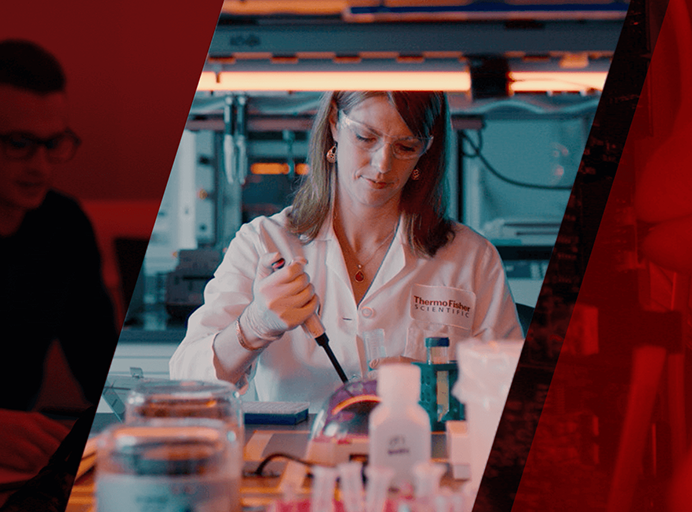By Kathy Lang
Senior Manager, Clinical Research
Thermo Fisher Scientific
After several years of battling an aggressive leukemia, with multiple rounds of chemotherapy and a bone marrow transplant, a 33-year-old professional gardener waits in a hospital room for what doctors hope is the last medical intervention to improve his quality of life. He’s surrounded by a team of caregivers who watch intently as a tiny bag containing about 6 million of his own cells, which have been modified to fight the disease, is slowly infused into his circulatory system through a needle in his arm.
“The process seemed almost too simple, even anticlimactic,” the patient says. “However, I am beyond grateful for the chance to live and, even more importantly, live life to the fullest.”
On the surface, getting an infusion of potentially life-saving cells may seem straightforward. But what happens behind the scenes to develop the contents of that tiny bag is far from trivial. It’s the end product of an intense process that involves not only technological and scientific innovation, but a strong commitment to collaboration among cell and gene therapy developers, clinicians, partners such as Thermo Fisher Scientific and, ultimately, patients.

Cell and gene therapy, one of the latest advancements in medicine, could not get any more personal. In autologous cell therapy, T-cells are harvested from a patient and modified to turn them into supercharged, cancer-killing cells before they are infused back into that same patient. Gene therapy is a technique that modifies a person’s genes to treat or cure disease. This is done by replacing a disease-causing gene with a healthy copy, inactivating a disease-causing gene that is not functioning properly or introducing a new or modified gene into the body.
While such treatment is usually implemented as a last resort for those who have relapsed or have become resistant to traditional standard of care, it has proved to be disease-modifying and, in some instances, even curative in a growing number of cases worldwide. These results are a testament to advancements in CGT research and clinical trials decades in the making.
A Field Ripe with Opportunity
The cell and gene therapy field holds great promise for patients and represents a significant growth area for biopharma. Scientists and clinicians have identified more than 7,000 molecularly based diseases, but only 500 have an existing treatment.1 Additionally, more than 2,000 CGT trials are active globally,2 and the number of developers worldwide (around 1,400) has increased by more than 10% from 2021 to 2022, according to the Alliance for Regenerative Medicine.3
The market for cell therapy was estimated at $4.77 billion in 2022 and is projected to grow at a compound annual rate of 16.5% between 2023 and 2030.4 To support this next chapter in personalized medicine, Thermo Fisher has built its global pharmaceutical services network, which now includes a new cGMP manufacturing facility adjacent to the University of California, San Francisco (UCSF) Medical Center.
Working in collaboration with UCSF clinical researchers and closer to patients, Thermo Fisher scientists and product specialists aim to expedite development of breakthrough treatments for conditions such as sickle cell disease and diabetes, as well as cancers such as glioblastoma and multiple myeloma, using updated approaches to chimeric antigen receptor (CAR) T-cell therapy and gene-editing technologies, including clustered regularly interspaced short palindromic repeats (CRISPR).
.jpg) Betty Woo, vice president, cell, gene and advanced therapies, Thermo Fisher Scientific
Betty Woo, vice president, cell, gene and advanced therapies, Thermo Fisher Scientific

Leveraging Broad Expertise to Meet Customer Needs
The result of strategic investments, Thermo Fisher’s global pharmaceutical services network is designed to support established and emerging developers across the cell and gene therapy continuum. The company leverages its deep product portfolio and expertise in contract development and manufacturing and clinical research to help customers navigate the chemistry, manufacturing, controls and regulatory landscape.
 Rupa Pike, senior director of technical affairs, advanced therapies, Thermo Fisher Scientific
Rupa Pike, senior director of technical affairs, advanced therapies, Thermo Fisher Scientific
Healthier
 Panteli Theocharous, global vice president, cell and gene therapy strategy lead, clinical research, Thermo Fisher Scientific
Panteli Theocharous, global vice president, cell and gene therapy strategy lead, clinical research, Thermo Fisher Scientific
While autologous therapy treats one patient with one product, allogeneic therapies leverage cells from one donor to develop thousands of cell products. This approach of developing “off-the-shelf” solutions has the potential to democratize cell therapies by further reducing costs and increasing accessibility to more patients, while also making them easier for clinicians to use.
“It’s all about strong partnerships, attention to detail and demonstrating sensitivity and empathy as we place ourselves in the shoes of patients and support them through a complex, long-term journey,” Theocharous says. “Personally, I always wanted to make a real difference to each and every patient journey. I want to help them achieve something very special – long-term remissions, cures and overall survival.”
Thermo Fisher’s Impact on CGT Industry
|
|


